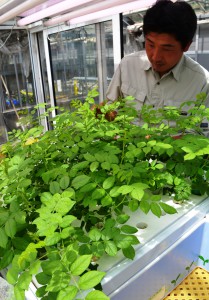Hayato Niki
A move toward domestic production of medicinal plant licorice is getting active. Licorice is used as an ingredient for herbal medicines of Kampo (Japanese adaptation of traditional Chinese medicine). This is because its stable supply is getting uncertain as China started to control licorice export on the ground of environmental protection. Japan depends on China for most of licorice import now. Some Kampo medicine manufacturers started to develop superior varieties or use contract farming. A research institute in Hokkaido applied for registration of a new variety suitable for Japanese climate. The institute is also promoting construction of cultivation systems such as development of harvesting machines.
Roots of licorice can be ingredients for Kampo medicines and are used in 70 percent of all the Kampo medicines in Japan. According to the Japan Kampo Medicines Manufacturers Association consisting of about 70 Kampo medicine manufactures, member companies used 1,267 tons of licorice in 2008, all of which were from China.
China, on the other hand, implemented regulations on licorice export in order to deal with increasing domestic demand and to protect environment by preventing indiscriminate gathering of wild plants. The foreign trade statistics of the Ministry of Finance reports the total imports of licorice in 2013 as JPY19.5 billion, of which imports from China accounted for JPY18.8 billion. The import price of Chinese licorice went up to JPY978 per kilogram, 2.3 times higher than that of 5 years ago.

he facility of the Research Center for Medical Plant Resources where seedlings of licorice “Koro Glu-0010” are grown by sticking(Nayoro City, Hokkaido)
Research Center for Medical Plant Resources of National Institute of Biomedical Innovation, an independent administrative institution in Nayoro City, Hokkaido, under the jurisdiction of the Ministry of Wealth, Labour and Welfare applied in June for registration of seeds and seedlings of licorice “Koro Glu-0010.” The center developed it in cooperation with Health Sciences University of Hokkaido. The content rate of medicinal ingredient glycyrrhizin acid stably meets the standard of 2.5 percent, which is required by “the Japanese Pharmacopoeia,” or written standards of pharmaceutical products. It had been difficult to meet the standard because of Japanese humid environment. It had been an obstacle for domestic cultivation of licorice.
The center is rushing toward construction of cultivation systems aiming at its broad use in 2017. From now on, the center will grow more licorice seedlings working with private manufactures of seeds and seedlings. As licorice is a minor crop, no appropriate pesticides have been registered. However, pendimethalin, which is used as herbicide, is expected to be registered as early as next year. The center has developed a harvesting machine in cooperation with Hokkaido Agricultural Research Center of National Agriculture and Food Research Organization. Using the machine, it takes about one fifth of the time needed for harvesting by a backhoe, and the machine can finish 6 meter of harvesting in about 3 minutes.
Shinnihonseiyaku, a pharmaceutical company in Fukuoka City, says “without raising the self-sufficiency degree of licorice, we might have troubles in manufacturing Kampo medicines,” and has developed a superior variety on their own. Last year, Shinnihonseiyaku set up a council with 4 cities and villages across the country such as Koshi City of Kumamoto Prefecture and Shingomura of Aomori Prefecture, and has promoted test growing. This year, however, the company shifted to contract farming with farmers in several parts of the country. Their licorice is expected to be harvested next year.
Takeda Pharmaceutical Company Limited (Osaka City) cultivated its original variety “Miyako No.1” and applied for its registration last year prior to the Research Center for Medical Plant Resources. Takeda has promoted experimental cultivation in Hokkaido since 2012.
The domestic market of Kampo medicines is expanding year by year. According to the Ministry of Health, Labour and Welfare, the domestic production value of Kampo drug products is JPY151.9 billion, which increased by 24 percent in 5 years. The Ministry of Agriculture, Forestry and Fisheries also thinks that demand for medical crops can be expected to expand. Therefore, in 2014, they are supporting preparation of cultivation manuals for each region. They also support improvement of farm machines by allocating JPY400 million to the new service, “Supporting Project for Production Region Creation of District’s Special Products including Medical Crops.”
(July 30, 2014)

